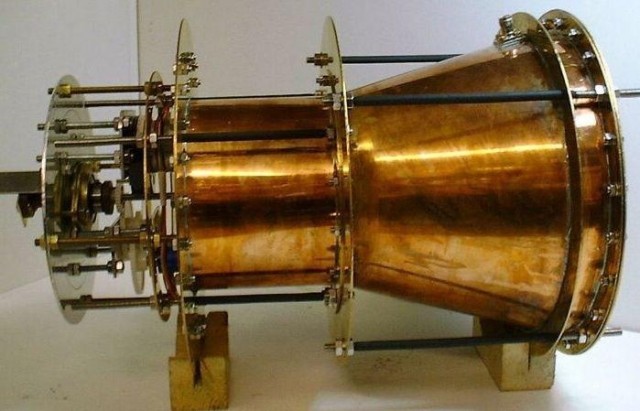
A fuel-free engine that appears to violate the known laws of physics has made headlines once again. Mike McCulloch, a lecturer at Plymouth University in the UK, recently put a hypothesis on the table that attempts to explain how the engine propels itself based upon a new theory of inertia.
The engine, known as the EM Drive, is powered by the sun, meaning it does not need fuel to trigger a reaction. It produces thrust by bouncing microwaves around in an enclosed chamber. Since the contraption does not need fuel, it is substantially lighter and easier to move than a conventional spacecraft. It can also reach incredibly high speeds, potentially traveling to Mars in as little as three weeks.
What makes the EM Drive so perplexing is that it seems to defy Newton’s conservation of momentum, which states, “for every reaction, there is an equal and opposite reaction.” Consequently, the EM Drive should be impossible, since it can perform an action (propulsion) without a corresponding reaction (ignition of fuel and expulsion of mass). And yet, the EM Drive seems to work.
A new theory of inertia
In an effort to explain this bewildering phenomena, McCulloch proposed a new hypothesis founded on ideas about inertia and the way bodies move under small accelerations. In particular, McCulloch suggests the inertia comes from an effect predicted by Einstein’s general theory of relativity known as Unruh radiation, which states accelerating object experience black body radiation. In other words, the universe heats up when you accelerate.

McCulloch suggests the EM Drive is due to pressure Unruh radiation exerts on an accelerated body, as noted in an MIT article:
“At very small accelerations, the wavelengths of Unruh radiation become so large they can no longer fit in the observable universe. When this happens, inertia can take only certain whole-wavelength values and so jumps from one value to the next. In other words, inertia must quantised at small accelerations.”
McCulloch added that since photons have an inertial mass, they must experience inertia when they reflect. Due to the EM Drive’s truncated cone, however, the Unruh radiation is small. This means the inertia of photons within the cavity alter as they vacillate back and forth. In order to conserve momentum, they generate thrust.
Flyby anomalies
McCulloch states there is direct evidence for this in the form of famous flyby anomalies in which spacecrafts acquire unexpected energy as they flyby Earth and other planets. This is precisely what McCulloch’s hypothesis predicts.
Although McCulloch’s hypothesis makes testable predictions, he is not without his critics. In an email exchange with Science Alert, RIT astrophysicist Brian Koberlein noted:
“The idea that the EM effect can account for the flyby anomaly is weak tea. To begin with, just because it can be made to fit under certain assumptions, it isn’t the same as predicting an effect. Secondly, there are lots of proposed explanations for the flyby effect, most of which are more mundane and don’t require exotic physics (such as radio chirps).”
In addition, McCulloch ‘s hypothesis isn’t the only scientific explanation for the flyby anomaly. The majority of other theories do not expound a new theory of inertia in order to explain the phenomena observed. Occam’s razor would advise to seek a simpler hypothesis with the fewest assumptions; although, Occam’s razor is more of a general guideline in science than it is an unshakable maxim. Nor is it certain that Unruh radiation even exists. McCulloch’s hypothesis is founded on another hypothesis, making it based on more speculation that scientists are comfortable with.
The EM Drive has the potential to transform the very nature of space travel or go down in history as an illustration of the need for more precise measurements. At any rate, if McCulloch’s hypothesis is falsified, it will help scientists narrow in on the kernel of truth behind the EM drive by weeding out dead ends.
Sources include:
Submit a correction >>
This article may contain statements that reflect the opinion of the author



















